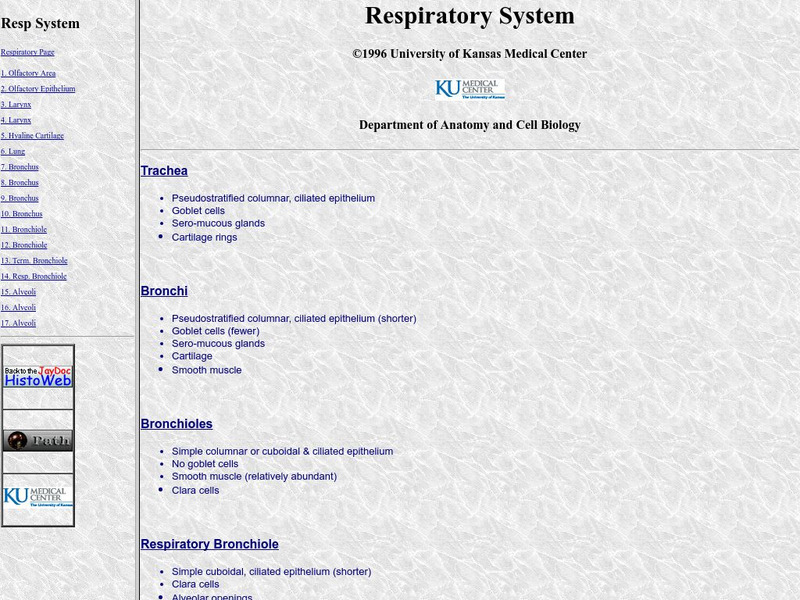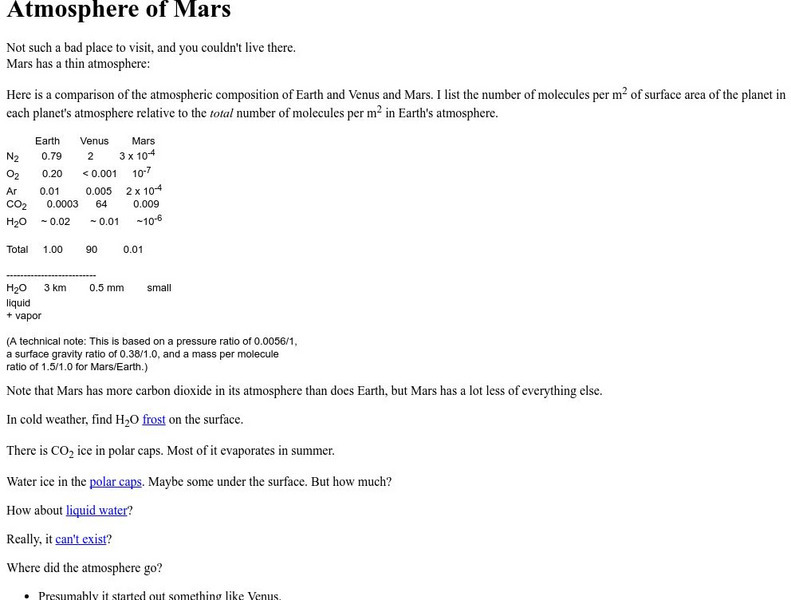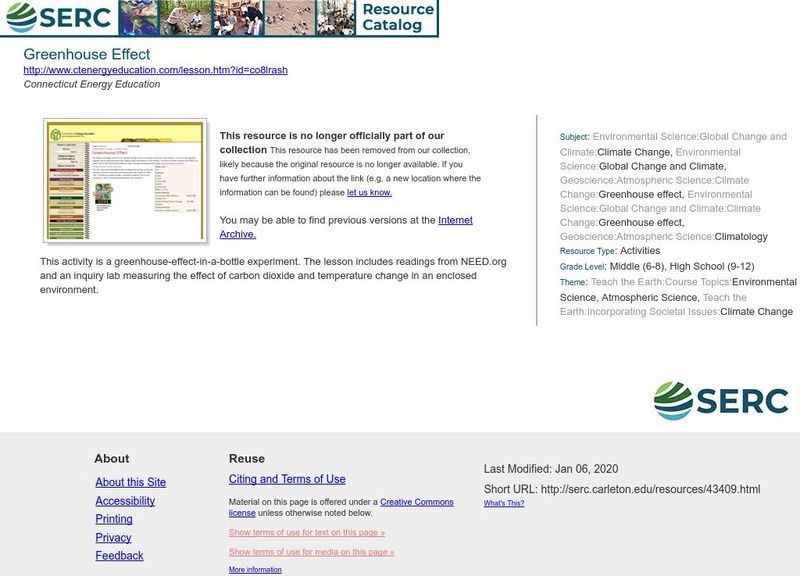PBS
Pbs: Earth Science Exploration
An earth science collection where students can explore earthquakes, volcanoes, and more natural phenomena. The collection uses videos and interactive activities to investigate our dynamic planet and earth systems.
Smithsonian Institution
Smithsonian Learning Lab: Prehistoric Climate Change and Why It Matters Today
In a lesson in this issue of Smithsonian in Your Classroom, students do the work of a team of paleontologists studying a time of rising carbon dioxide and rapid global warming during the Eocene epoch. By examining fossils of tree leaves,...
Exploratorium
Exploratorium: Ice Stories: Dispatches From Polar Scientists: Greenhouse Gases
Polar scientists offer an article identifying the research and observations made on greenhouse gases. Why is there so much carbon dioxide in the atmosphere today? Scientists work diligently to determine the causes and effects of these...
University of Kansas Medical Center
University of Kansas Medical Center: Respiratory System
What do you know about the respiratory system? Check out this site to learn more about this fascinating body system. This resource features slides of the different parts of this system.
University of Oregon
University of Oregon: Mars' Atmosphere
Here is a comparison of the atmospheric composition of Earth, Venus and Mars.
Science Education Resource Center at Carleton College
Serc: Investigating Discovering What Plants Need for Photosynthesis
This activity will be used prior to any direct instruction for photosynthesis. In this inquiry lab, students design and conduct simple experiments using elodea and Bromthymol blue to determine whether plants consume or release carbon...
Science Education Resource Center at Carleton College
Serc: Visualizing Carbon Pathways
This lesson introduces students to visualization capabilities available through NASA's Earth Observatory, global map collection, NASA NEO and ImageJ. Students build several animations of satellite data that illustrate carbon pathways...
Science Education Resource Center at Carleton College
Serc: Estimating Our Carbon Footprint
This is a three-part algebra activity focusing on food-related carbon dioxide emissions.
Simon Fraser University
Chem1 Virtual Textbook: Origin and Evolution of the Atmosphere
As part of the General Chemistry Virtual Textbook, this site examines a variety of topics related to the Earth's atmosphere. Included in the discussion are topics such as prebiotic atmosphere, origin of atmospheric oxygen, carbon...
PBS
Pbs Kids: Dragonfly Tv Do It: Carbon Dioxide
PBS site offers an experiment kids can do at home to see how carbon dioxide can put out burning candles.
Society for Science and the Public
Science News for Students: Carbon Dioxide Levels Rise Fast and High
The buildup of carbon dioxide in the atmosphere is rising faster than at any time since dinosaurs roamed the Earth. The burning of fossil fuels is largely to blame.
TED Talks
Ted: Ted Ed: How Quantum Mechanics Explains Global Warming
You've probably heard that carbon dioxide is warming the Earth. But how exactly is it doing it? Lieven Scheire uses a rainbow, a light bulb and a bit of quantum physics to describe the science behind global warming. [5:01]
TED Talks
Ted: Ted Ed: Climate Change: Earth's Giant Game of Tetris
There's a game of Tetris happening on a global scale: The playing space is planet Earth, and all those pesky, stacking blocks represent carbon dioxide- a greenhouse gas that is piling up ever more rapidly as we burn the fossil fuels that...
TED Talks
Ted: Ted Ed: Is Our Climate Headed for a Mathematical Tipping Point?
Scientists have warned that as CO2 levels in the atmosphere rise an increase in Earth's temperature by even two degrees could lead to catastrophic effects across the world. But how can such a tiny, measurable change in one factor lead to...
Museum of Science
Museum of Science and Industry: Online Science: Create Gas
Follow these simple, step-by-step instructions to create and observe the results of the chemical reaction between vinegar and baking soda.
Other
Carbon Footprint : Carbon Footprint Calculator
Find out your carbon footprint with this easy-to-use calculator. See the difference in your carbon emissions depending on which mode of transportation you use.
PBS
Greenhouse Green Planet
Why is the earth just the right temperature to support life? The answer is the greenhouse effect, and you can learn more about it using this resource.
Climate Literacy
Clean: How Does Temperature Affect the Solubility of Co2 in Water?
This short investigation from Carbo Europe explores how temperature relates to the solubility of carbon dioxide in water.
Climate Literacy
Clean: Greenhouse Gases: A Closer Look
One activity in a larger module covering different aspects of the major greenhouse gases including some of the ways in which human activities are affecting the atmospheric concentrations of these key greenhouse gases.
Science Education Resource Center at Carleton College
Serc: How Greenhouse Gases Absorb Heat
In this experiment students observe two model atmospheres: one with normal atmospheric composition and another with an elevated concentration of CO2. These two contained atmospheres will be exposed to light energy in a sunny window or...
Science Education Resource Center at Carleton College
Serc: Greenhouse Effect
An inquiry lab measuring the effect of carbon dioxide and temperature change in an enclosed environment to simulate the greenhouse effect.
US Environmental Protection Agency
Epa: Global Warming Wheel Card [Pdf]
Students construct a Global Warming Wheel Card, a hand-held tool that they can use to estimate their household's emissions of carbon dioxide and learn how they can reduce them.
Other
Breathing Earth
Breathing Earth layers data about rates of carbon dioxide emission along with birth and death rates onto a map of the world in a real-time simulation of one of the principal greenhouse gases in the Earth's atmosphere, CO2.
NASA
Space Math: Nasa Satellite "Sees" Carbon Dioxide [Pdf]
Using this map from NASA you can calculate the concentrations of carbon dioxide in the atmosphere. Solve the four problems and you will see how concentrations are spread across the globe and where there are regional differences.






















![Epa: Global Warming Wheel Card [Pdf] Activity Epa: Global Warming Wheel Card [Pdf] Activity](https://content.lessonplanet.com/knovation/original/84558-16fbabe6543bc08a2c6e61c7cc193c00.jpg?1661812588)
